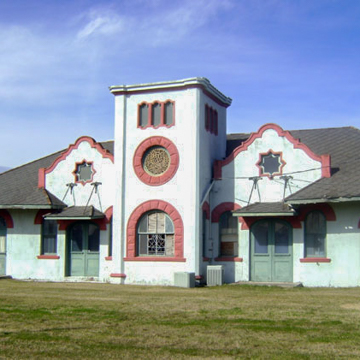The Colorado Southern, New Orleans and Pacific Railroad, which reached Crowley from Eunice, St. Landry Parish, in 1907, was one of several lines that enabled the town to become a milling and transportation center for southwest Louisiana’s rice industry. Crowley, founded in 1887 by brothers Cornelius C. and William W. Duson, had acquired large tracts of land in the area and began to promote settlement through the W. W. Duson and Bro. Real Estate Co. The Dusons also cultivated rice, and the success of this regional industry is apparent in the rice mills and storage silos that still line the town’s railroad tracks.
Architect Page of Austin, Texas, produced a Mission Revival design for this building, the city’s only surviving depot. Symmetrical in plan and elevation, it has two entrances, each of which led to a large square waiting room, one for black patrons and the other for whites. The ticket office stood between the waiting rooms. A square tower projects from the center of the building’s trackside facade, which provided spaces for the station master to observe approaching and departing trains. Originally surmounted by a square cupola, the tower is pierced by three windows, arranged vertically, each a different shape—round-arched at the lowest level, circular above, and a triple-divided rectangle at the top—all with prominent voussoirs or frames. The depot’s low hipped roof, which extends beyond the walls and was originally covered with red tiles, is pierced on both facades with scrolled gables, each with a star-shaped window. The brick walls have an off-white stucco finish and window frames and cornices are painted dark red. The small, square hip-roofed structure near the depot at the corner of N. Parkerson Avenue and East 1st Street was built in 1903 to house the Wells Fargo Railway Express Office.














